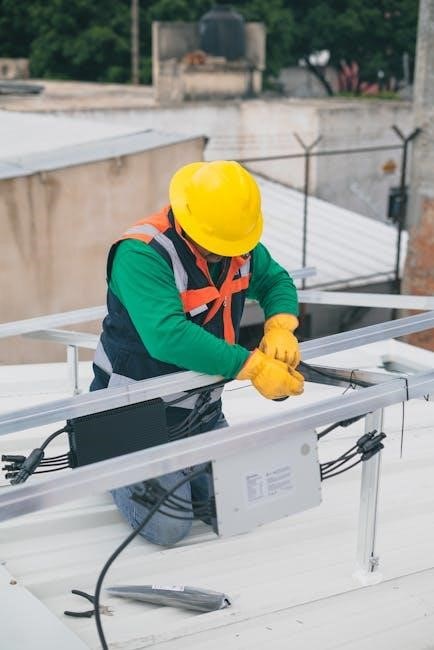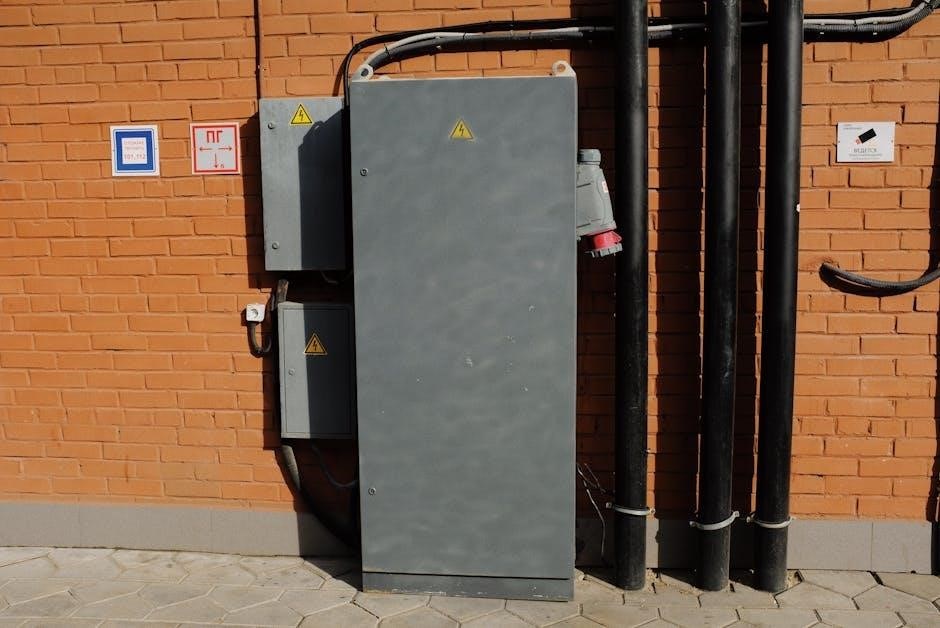Manual stackers, or montacargas manual, are cost-effective solutions for lifting and moving heavy loads in industrial and commercial settings, designed to optimize logistics with minimal maintenance and easy operation․
Definition and Purpose
Manual stackers, or montacargas manual, are mechanical devices designed to lift and move heavy loads in industrial and commercial environments․ They are often referred to as hand trucks or pallet jacks and serve to improve efficiency and safety in material handling․ Their primary purpose is to simplify the transportation and stacking of goods, making them essential tools in warehouses, factories, and logistics centers․
History and Evolution
Manual stackers, or montacargas manual, were introduced as an alternative to traditional combustion forklifts, offering a cost-effective and efficient solution for material handling․ Their simplicity, low maintenance, and ease of use made them a preferred choice for logistics, distribution, and export businesses․ Over time, they have evolved to optimize workflow and enhance safety, becoming essential tools in modern industrial operations․
Types of Manual Stackers
Manual stackers include hydraulic models, pallet jacks, and specialized designs, each tailored for specific tasks, ensuring efficient material handling in various industrial and commercial environments․
Hydraulic Manual Stackers
Hydraulic manual stackers use a manual hydraulic pump to lift heavy loads, offering precise control and efficiency․ These models are ideal for industrial settings, providing reliable performance with minimal effort․ Their robust design ensures durability, making them a practical choice for warehouses and manufacturing plants․ Regular maintenance is essential to uphold their operational efficiency and longevity․
Manual Pallet Jacks
Manual pallet jacks are simple, cost-effective tools designed for moving and positioning pallets in warehouses and logistics environments․ They feature a hydraulic lifting mechanism, enabling easy load handling with minimal effort․ Compact and maneuverable, they are ideal for tight spaces, offering reliability and efficiency in material handling operations․ Regular maintenance ensures optimal performance and longevity․
Specialized Manual Stackers
Specialized manual stackers are tailored for specific tasks, offering unique features like adjustable forks for various pallet sizes or heavy-duty construction for high-capacity loads․ Designed for precision and versatility, they are ideal for tight spaces or niche applications, enhancing efficiency and safety in material handling across industries such as manufacturing, retail, and logistics․ Ergonomic designs ensure operator comfort and control․
Safety Procedures and Training
Proper training is essential for safe operation of manual stackers․ Operators must understand safety protocols, equipment limitations, and emergency procedures to minimize risks․ Regular drills and adherence to guidelines ensure a secure working environment, reducing incidents and enhancing compliance with industry standards․
Operator Training Requirements
Operators of manual stackers must undergo comprehensive training to ensure safe and efficient operation․ Training covers safety protocols, equipment-specific instructions, load handling, and emergency procedures․ Certification, such as the DC-3 document, is often required to operate these devices legally․ Practical training and regular updates on new safety standards are essential to maintain proficiency and reduce workplace accidents․
Pre-Operational Safety Checks
Before operating a manual stacker, conduct thorough safety inspections of hydraulic systems, forks, and wheels․ Ensure proper lubrication and check for wear or damage․ Verify load capacity and stability to prevent overloading․ Inspect control mechanisms and ensure all safety features function correctly․ Document findings and address any issues before use to minimize risks and ensure safe operation․
Emergency Procedures
In case of emergencies, operators should remain calm and immediately secure the load․ Evacuate the area if necessary and contact trained personnel or emergency services․ Never attempt to handle unstable or damaged equipment without proper assistance․ Regular safety drills and adherence to guidelines can prevent incidents and ensure swift, effective responses to emergencies․
Structure and Mechanism
Manual stackers consist of a hydraulic system, mast, and forks․ The hydraulic system, powered by a manual pump, lifts loads, while the mast and forks ensure stability and cargo handling․
Key Components (Hydraulic System, Mast, Forks)
The hydraulic system uses a manual pump to lift heavy loads efficiently․ The mast provides structural support, while the forks securely engage with pallets․ These components work together to ensure safe and precise load handling, making manual stackers durable and reliable for various industrial applications․
Working Principle
The manual stacker operates using a hydraulic system activated by a manual pump․ The operator lifts loads by moving the handle, which pressurizes hydraulic fluid to raise the forks․ This mechanism allows for precise control and efficient lifting of heavy objects, ensuring stability and safety during operation․ The system is designed for smooth, consistent performance in various industrial environments․
Load Capacity and Stability
Manual stackers are designed to handle various load capacities, typically ranging from 1 to 3 tons, depending on the model․ Stability is ensured through a low center of gravity and a wide base, preventing tipping․ Proper load distribution and adherence to weight limits are crucial for safe operation, ensuring the equipment remains balanced and functional in demanding environments․
Advantages and Benefits
Manual stackers offer economic efficiency, low maintenance, and environmental benefits, making them a versatile and reliable choice for warehouses, logistics, and commercial spaces, enhancing operational efficiency․
Economic Efficiency
Manual stackers provide cost-effective solutions for businesses by reducing labor costs and minimizing the need for complex infrastructure․ Their affordable purchase price and low operating expenses make them a budget-friendly option, ideal for small to medium-sized operations․ This efficiency allows companies to allocate resources more effectively, improving overall profitability and operational capacity․
Low Maintenance
Manual stackers are designed for simple upkeep, featuring durable constructions that minimize repair needs․ Their hydraulic systems and moving parts require infrequent servicing, reducing downtime and operational costs․ This makes them a practical choice for businesses seeking reliable, long-lasting equipment with minimal maintenance demands․ Regular inspections ensure optimal performance, further extending their operational lifespan․
Environmental Impact
Manual stackers are an eco-friendly alternative to powered equipment, producing no emissions and operating quietly․ Their energy-efficient design reduces reliance on electricity, making them a sustainable choice for businesses aiming to lower their environmental footprint․ This makes them ideal for companies prioritizing green practices and minimizing operational noise in sensitive work environments․
Maintenance and Repair
Regular inspections and lubrication of moving parts ensure optimal performance․ Addressing wear and tear promptly prevents breakdowns, extending the equipment’s lifespan and reliability in daily operations․
Regular Maintenance Schedule
A daily inspection ensures optimal functionality․ Lubricate moving parts weekly and check hydraulic systems monthly․ Replace worn components promptly to prevent breakdowns․ Schedule professional servicing annually for thorough evaluation and maintenance, ensuring longevity and reliability of the equipment․ Regular upkeep minimizes downtime and enhances workplace safety․
Common Repairs and Troubleshooting
Common repairs include addressing hydraulic leaks, replacing worn seals, and repairing faulty lifting mechanisms․ Regular inspections help identify issues early․ Troubleshooting involves checking fluid levels, ensuring proper load distribution, and verifying the condition of hydraulic pumps․ Promptly replacing damaged components prevents major breakdowns and ensures smooth operation․ Always refer to the manual for specific repair guidelines․
Extending Equipment Lifespan
Regular maintenance, proper storage, and adherence to load limits are essential for prolonging the lifespan of manual stackers․ Lubricate moving parts, clean the equipment after use, and store it in a dry, secure area․ Operator training ensures proper handling, reducing wear and tear․ Following manufacturer guidelines helps maintain performance and longevity, minimizing downtime and repair costs․
Applications in Different Industries
Manual stackers are widely used in warehouses, manufacturing plants, and retail spaces for efficient material handling, enabling easy movement and stacking of pallets in tight spaces․
Warehouses and Logistics
Manual stackers are essential in warehouses for efficiently moving and stacking pallets, ensuring smooth logistics operations․ Their compact design and ease of use make them ideal for tight spaces, improving efficiency and safety while reducing costs․ These tools are widely adopted by importers, exporters, and logistics companies worldwide for reliable material handling in fast-paced environments․
Manufacturing Plants
Manual stackers are vital in manufacturing plants for handling heavy machinery parts and raw materials․ Their ability to lift and move loads efficiently supports production workflows, reducing downtime․ These tools are especially useful in tight spaces, ensuring safe and precise material handling while minimizing operational costs and enhancing workplace efficiency․
Retail and Commercial Spaces
Manual stackers are essential in retail and commercial environments for efficiently moving products and inventory․ Their compact design makes them ideal for tight spaces, allowing staff to restock shelves and manage stockrooms safely․ These tools enhance operational efficiency, reduce physical strain, and improve organization in busy commercial settings, ensuring smooth workflow and customer satisfaction․
Future Trends and Innovations
Manual stackers are evolving with the integration of smart technology, energy efficiency improvements, and customization options, enhancing their functionality and adaptability in modern logistics and industrial operations․
Integration of Smart Technology
The integration of smart technology into manual stackers enhances efficiency through IoT connectivity, real-time monitoring, and automation․ Sensors optimize load management, while data analytics improve workflow management․ Smart systems enable predictive maintenance and operator training, reducing downtime and increasing safety․ This innovation aligns with Industry 4․0 standards, making manual stackers more adaptive to modern logistics demands․
Energy Efficiency Improvements
Manual stackers are evolving to become more energy-efficient, reducing environmental impact․ Lightweight materials and optimized hydraulic systems minimize energy consumption․ Eco-friendly designs lower operational costs and align with sustainability goals․ These improvements make manual stackers a greener choice for modern logistics, enhancing their appeal in environmentally conscious industries․ Energy-efficient models are now a priority in their development and adoption․
Customization Options
Manual stackers now offer tailored solutions to meet specific industry needs․ Manufacturers provide adjustable mast heights, varying fork sizes, and customizable load capacities․ Optional features include ergonomic handles, swivel wheels, and corrosion-resistant finishes․ These options allow businesses to optimize their stackers for unique workspace requirements, enhancing efficiency and adaptability in diverse operational environments․ Customization ensures better fit and performance for specific tasks․
Safety Risks and Prevention
Operators of montacargas manual face hazards like collisions, falls, and equipment tip-overs․ Proper training, regular maintenance, and adherence to safety guidelines are essential to mitigate these risks effectively․
Common Hazards in Operation
Common hazards when operating montacargas manual include collisions, falls, equipment tip-overs, and the risk of being struck by moving parts․ Proper training and adherence to safety protocols are crucial to minimize these risks and ensure safe operation in industrial environments․ Regular inspections and maintenance also play a key role in preventing accidents and ensuring operator safety․
Strategies for Risk Mitigation
To mitigate risks when operating montacargas manual, implement operator training, conduct regular maintenance checks, and ensure proper load management․ Use safety gear, clear communication, and spotters in busy areas․ Adhere to load capacity limits and maintain a clean workspace to reduce accidents․ Regular inspections and emergency protocols further enhance safety, ensuring safe and efficient operations․
Regulatory Compliance
Montacargas manual operations must comply with safety standards and regulations, ensuring operator certification and proper equipment maintenance․ Operators must hold the DC-3 document to legally operate these devices․ Compliance involves adhering to load capacity limits, safety protocols, and regular inspections to prevent accidents and meet workplace safety regulations effectively․ This ensures safe and lawful operation in all industries․










































































